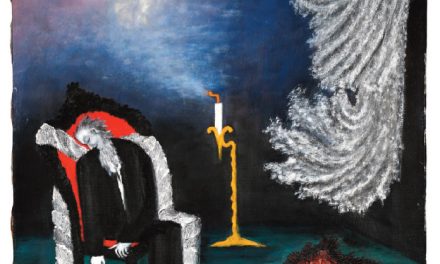Who Was Marian Spore Bush?
Marian Spore Bush was born on October 22, 1878, in Bay City, Michigan as Flora Mae Spore. Incredibly bright, she graduated from the University of Michigan in dentistry in 1899 and became the first female dentist in Bay County. She ran a successful practice in Bay City for 18 years until the death of her mother, Helen, in 1919. Marian had been very close to her mother, and her death left Marian extremely depressed.
Image of Marian from her autobiography “They.”
Enter the Ouija Board
A few strange events led Marian to the Ouija board, which was very popular in 1919. After working with the board for a while and finally feeling like she had communicated with her mother’s spirit, another group of otherworldly beings entered Marian’s life through the use of the Ouija. She would refer to them as “They” for the rest of her life.
“They” initially began as a collective of dead artists who instructed Marian to start drawing and eventually oil painting. Marian had no formal art training, but her early drawings had a whimsical style. As she started to take up the paintbrush, “They” instructed her to create fantastical, surreal images that often felt symbolic.
She officially began her full-time art career after she moved into a Greenwich Village apartment, an artsy and Bohemian part of New York City. Newspapers picked up on her abilities around 1922, and for years she was known to the media as the artist who was guided by the dead. As the years went on, she was described more as a painter who was able to tap into her subconscious to paint, rather than speak to ghosts. Marian may have preferred this redirect of her narrative, seeing as the press really ran with the ghost theme, and she was often described as a “medium” or “Spiritualist,” which she did not like at all as she did not consider herself as either. Marian felt that anyone could tap into the source she did and that they did not have to be a medium to do it. Marian abhorred Spiritualism, mainly because of the negative reputation it had as a scene rampant with trickery and fraud. But Marian never changed her belief in “They” and always stayed true to the story of how her ability came to her.
Marian Spore Bush’s Signature Style
Many of her pieces were done on a grand scale with canvases sized 5’ x 3.5’ ft. with bright and vivid colors, one of the first things art critics observed and loved. She would also spread paint so thickly in parts of her work that the paintings took on a bas-relief look. Many of her flower paintings were done in this style.
In the early 1930s, heavily influenced by her predictions of World War II and the actual onset of the war, she painted a series of visually striking and ominous, somewhat monochrome symbolic images with titles such as “Famine,” “Greed,” and “Hitler Meeting the Face of God.” This darker style was the theme of much of her work until the end of her life.
The Angel of the Bowery
In 1927, Marian began a breadline in the Bowery district of New York City, an area more downtrodden than other parts. She saw so many people suffering and knew that if they could just get some help and guidance, they could continue down a better path. Marian used her own money and also received some donations from wealthy friends. Marian herself had become wealthy with her successful dental practice and some smart stock investments.
Marian never revealed who she was and never bragged about her endeavor. It wasn’t about her; it was about the needy people. She was just known as “The Angel of the Bowery.” The media blew her cover with headlines such as “Reveal Bowery Angel As Spirit Painter” from the February 25, 1930, edition of The Brooklyn Daily Eagle.
She made headlines again when she married Brooklyn industrialist and head of the Bush Terminal Company, Irving T. Bush, on June 9, 1930. The marriage sent shockwaves through the gossip channels. Irving had been married to his second wife, Maude, so a short stay in Reno led to a quick divorce and marriage to Marian on the same day. In 1931, after four years, Marian ended her breadline. Others had picked up the torch, and there were breadlines all over the city inspired by her generous charity. She and Irving seemed happy together, and he found her one of the most amazing people he had ever met. Marian passed away on February 24, 1946, at the age of 67.


